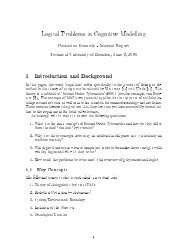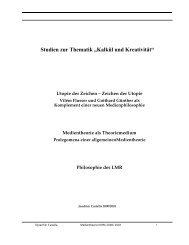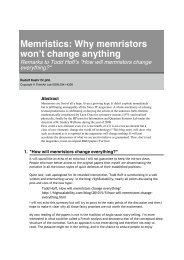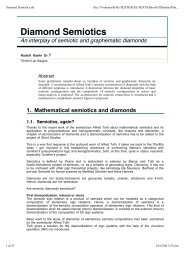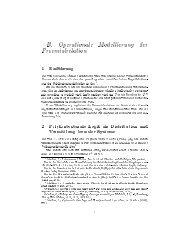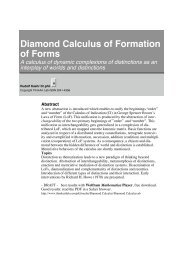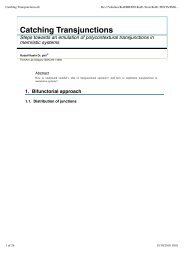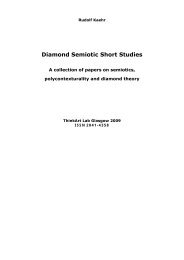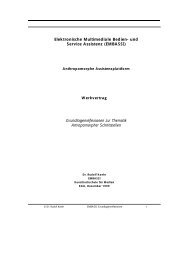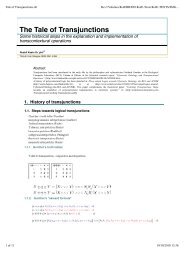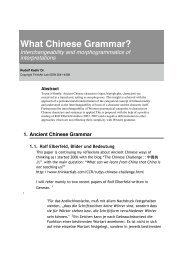Toth's semiotic diamonds - ThinkArt Lab!
Toth's semiotic diamonds - ThinkArt Lab!
Toth's semiotic diamonds - ThinkArt Lab!
Create successful ePaper yourself
Turn your PDF publications into a flip-book with our unique Google optimized e-Paper software.
2 <strong>Toth's</strong> Semiotics.nb<br />
In concreto, it still has to be analyzed how the <strong>semiotic</strong> matching conditions for compositions are realized.<br />
In the example above, the question is, how is “2.1” in (3.1 Ø 2.1) as a codomain and in (2.1 Ø 1.3) as a domain<br />
defined?<br />
The new question which arises for abstract diamond theory is: How are the difference relations and hence the<br />
hetero-morphisms defined in concreto?<br />
I had the idea that the papers of Toth are filling this gap with his <strong>semiotic</strong> modeling of <strong>diamonds</strong>. But it turned out<br />
that there is a cricial difference between ‘semiotische Diamanten” and categorical <strong>diamonds</strong>.<br />
Therefore, there is still an open question about a <strong>semiotic</strong> concretization of categorical <strong>diamonds</strong>.<br />
Toth is suggesting an answer to the question, how to interpret the difference relations, with the introduction of the<br />
operation of inversion INV of a concrete sign scheme. Hence, Toth’s interpretation of <strong>diamonds</strong> tries to join<br />
together <strong>semiotic</strong> and diamond thematizations and notational systems.<br />
Inversion<br />
Where is this operation INV from?<br />
The sign relation ZR is defined as a relation of monadic, dyadic and triadic relations:<br />
ZR = (a, (aïb), (aïbïc).<br />
Sign values for ZR are:<br />
a = {1.1, 1.2, 1.3}<br />
b = {2.1, 2.2, 2.3}<br />
c = {3.1, 3.2, 3.3}<br />
ZR = with x,y,zœ{1,2,3} and x§y§z.<br />
It is clear, that the <strong>semiotic</strong> inversion operation INV is a <strong>semiotic</strong> operation based on the elementary operations of<br />
transpositions and is not leading out of the <strong>semiotic</strong> domain.<br />
INV is defined by:<br />
INV(a.b c.d e.f) = (e.f c.d a.b).<br />
In contrast, dualization is defined as:<br />
DUAL(a.b c.d e.f) = (f.e d.c b.a).<br />
The abstract sign scheme gets an interpretation by the introduction of the instances:<br />
I = interpretant, M=medium and O=object.<br />
Hence, the <strong>semiotic</strong> triad occurs as morphisms between the instances I, O, M and their combinations, called<br />
graph theoretic sign models.<br />
1. (IöO öM) 4. (OöMöI)<br />
2. (MöOöI) 5. (IöMöO), (MöIöO)<br />
3. (IöMö O) 6. (OöIöM).<br />
It is proposed by the Stuttgarter School of <strong>semiotic</strong>s (Bense, Walter) that those triadic sign schemes can be<br />
composed by their dyadic relations (mappings).<br />
Most of the <strong>semiotic</strong> work is in German, thus it is easily possible that I will miss the correct terminology.<br />
Example:<br />
2. (M ï O) (O ï I) = (M ï O • Oï I)<br />
Hence, triadic-trichotomic sign relations are compositions of dyadic-dichotomic relations. This is a strong thesis,<br />
and I don’t see the necessity of such a reduction.<br />
Even more problematic, Elisabeth Walter (1979, S. 79), speaks of a lattice theoretical union of “(M ï O) (O ï I)<br />
= (M ï O.Oï I)". (Toth, (2008b), p.11)<br />
Bense (1976) is mentioning a category theoretical composition of the triadic sign conceived as a transition from<br />
the set theoretic and relational definition to a more adequate presentation (Darstellung) of <strong>semiotic</strong>ity .<br />
In the following, I will first follow this strategy, then I will focus on the composition of triadic-trichotomic sign<br />
structures as such.<br />
The diamondization of the internal relations of signs might be called micro-analysis, the focus on the latter macro-



